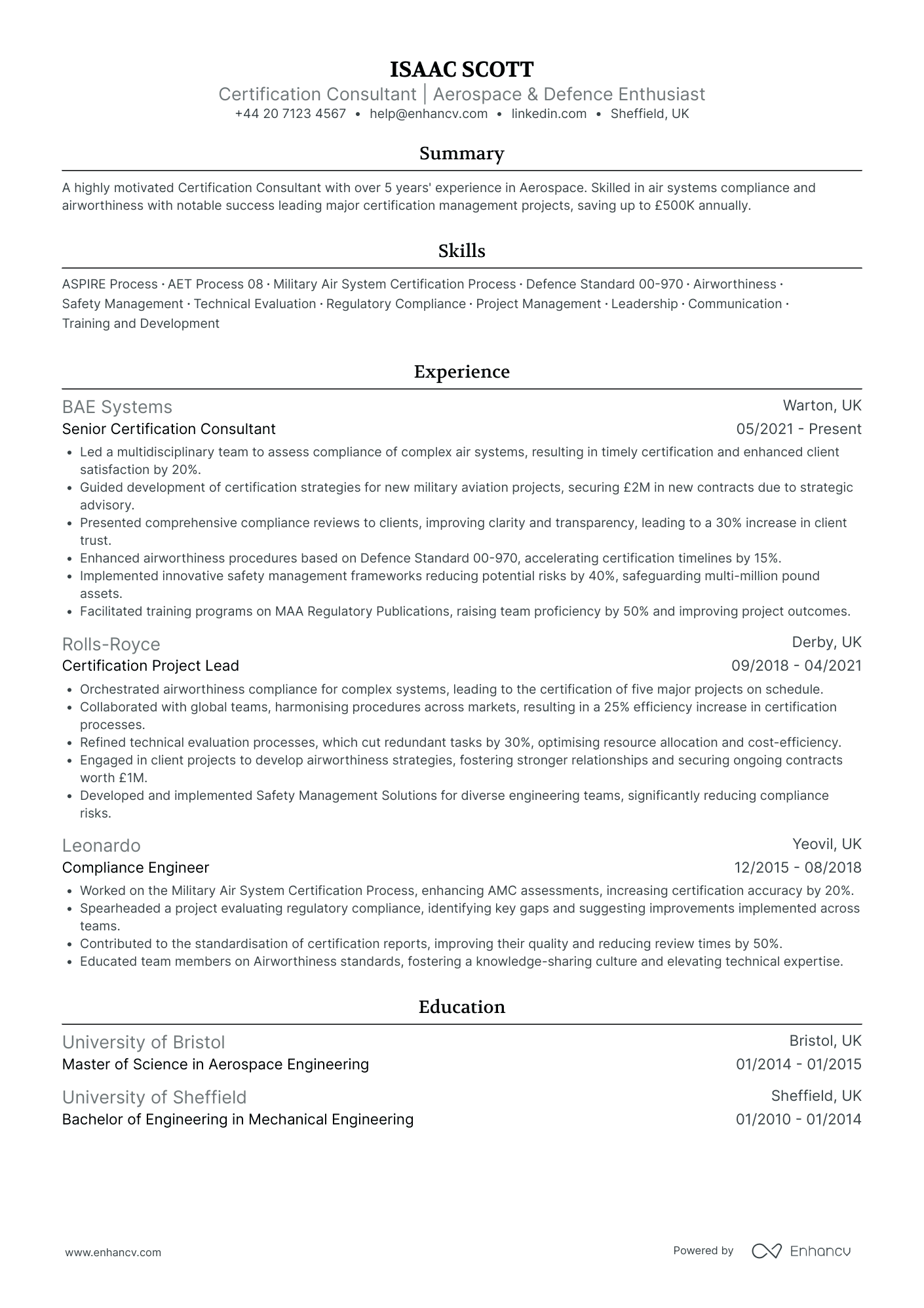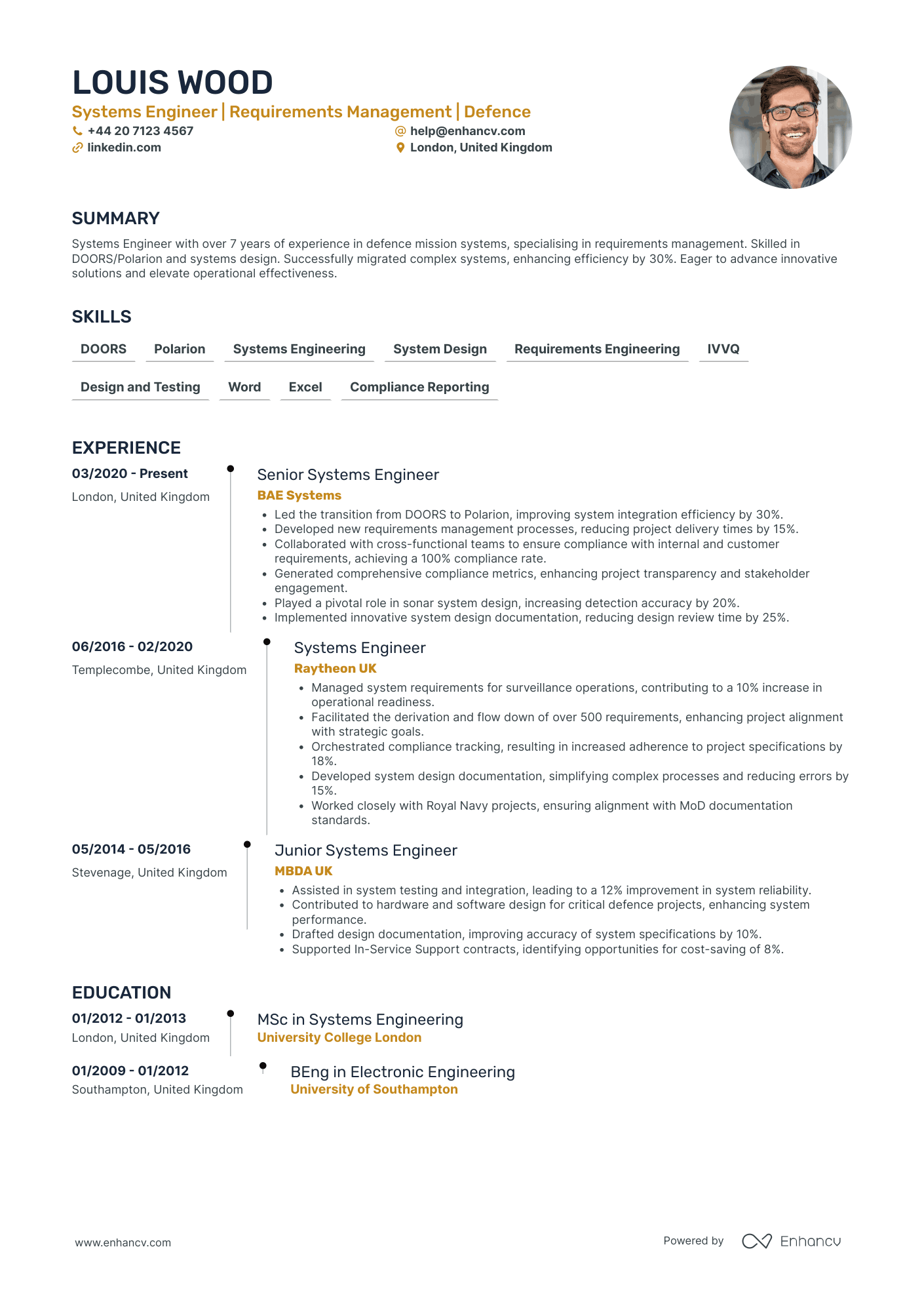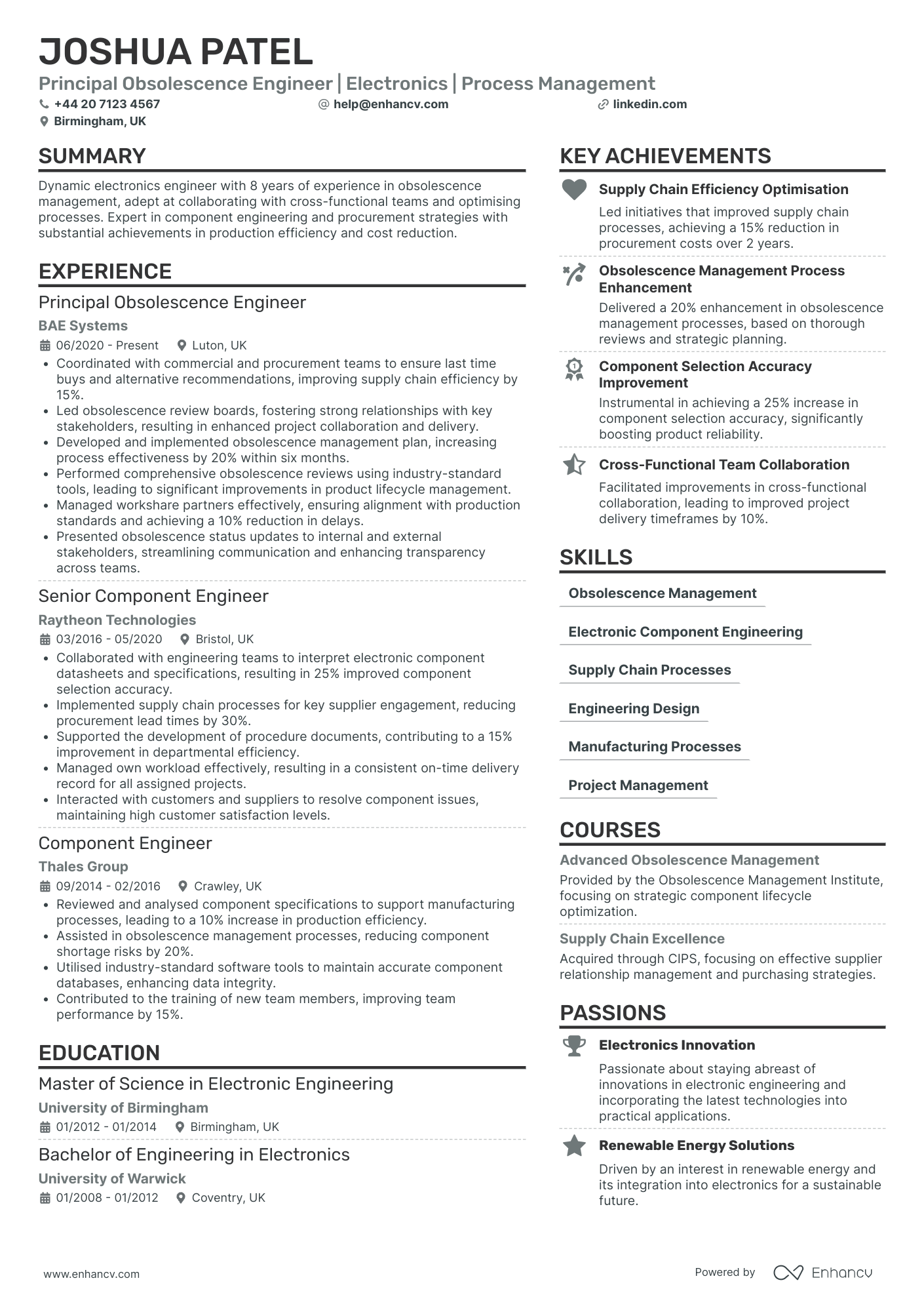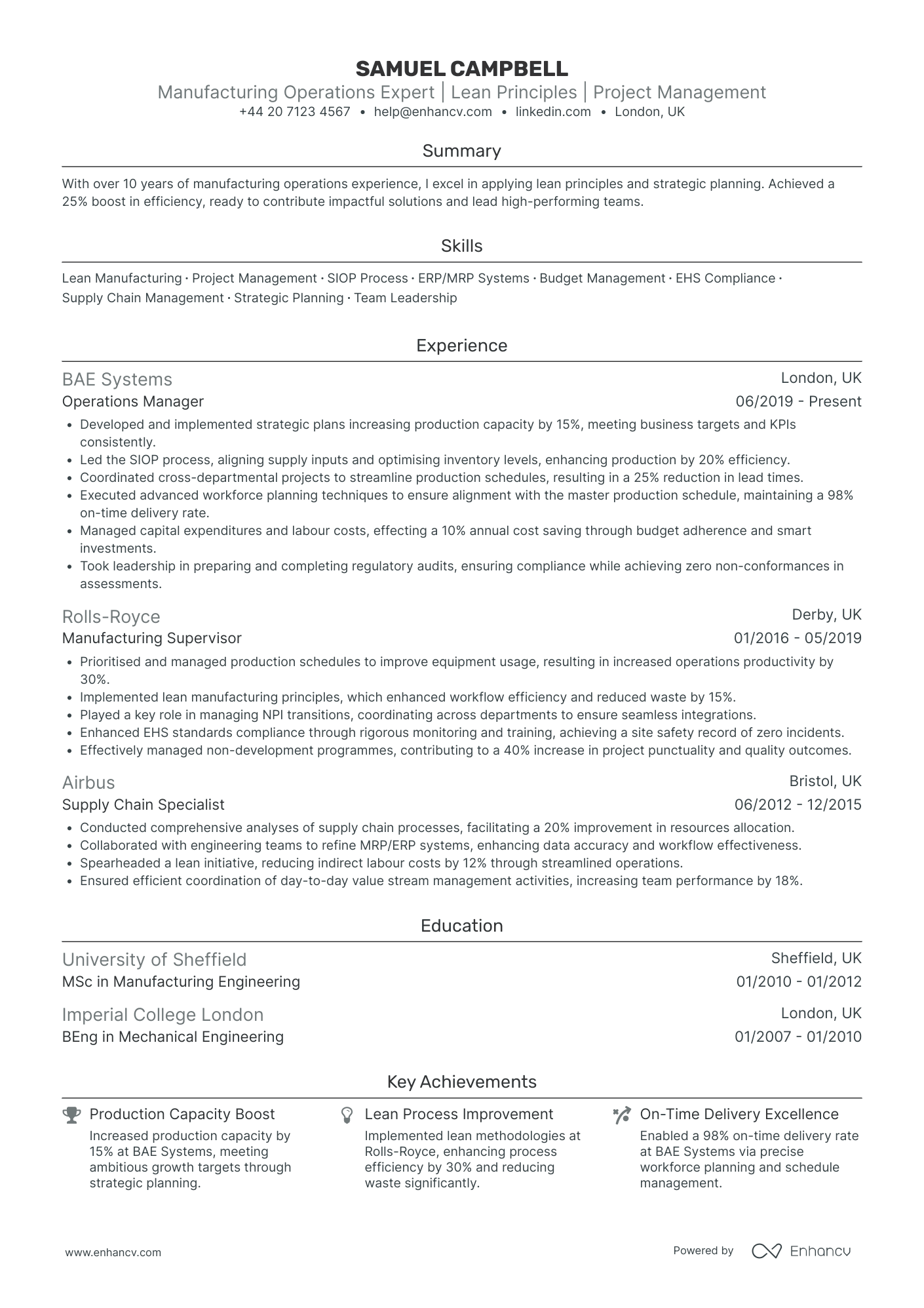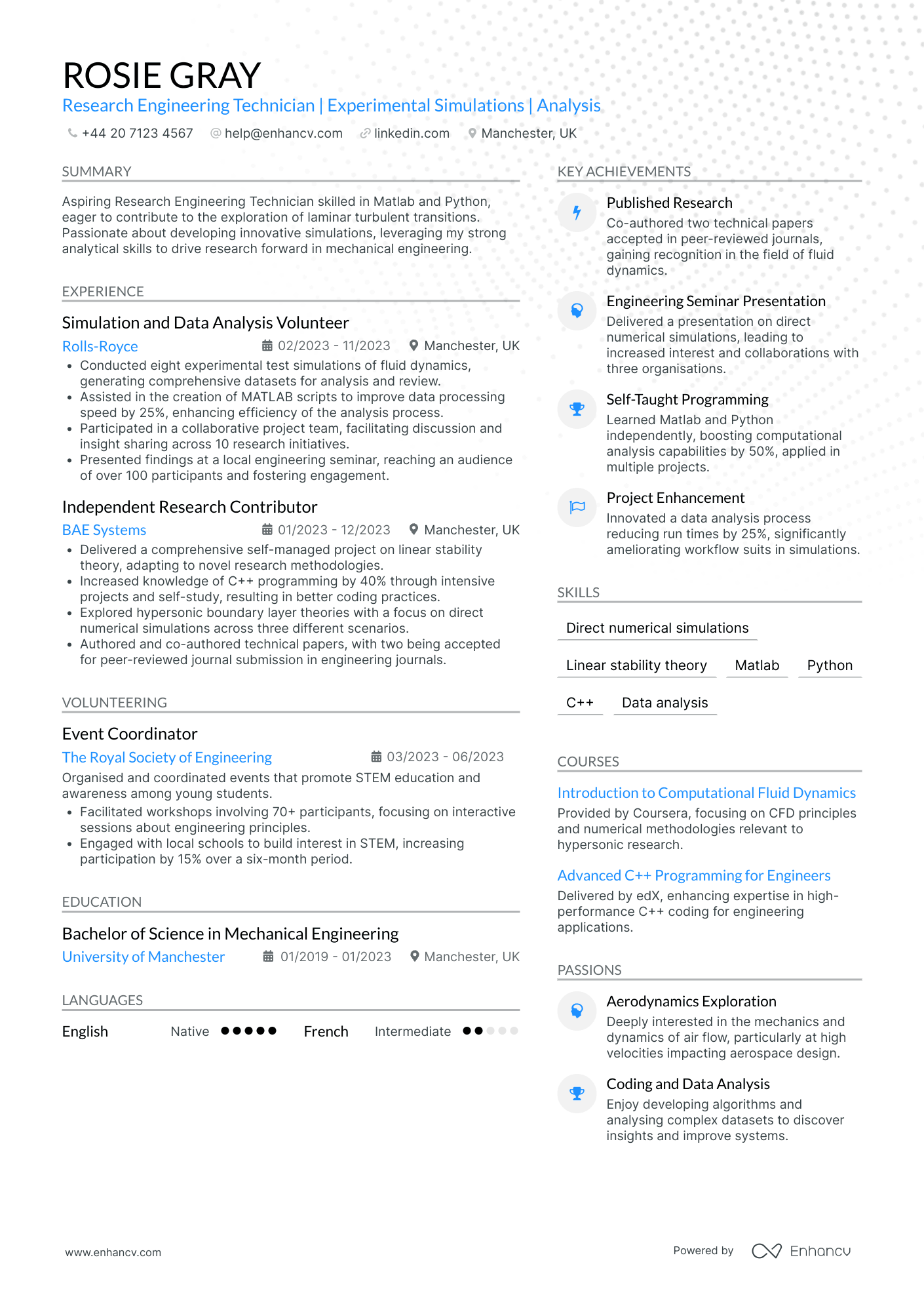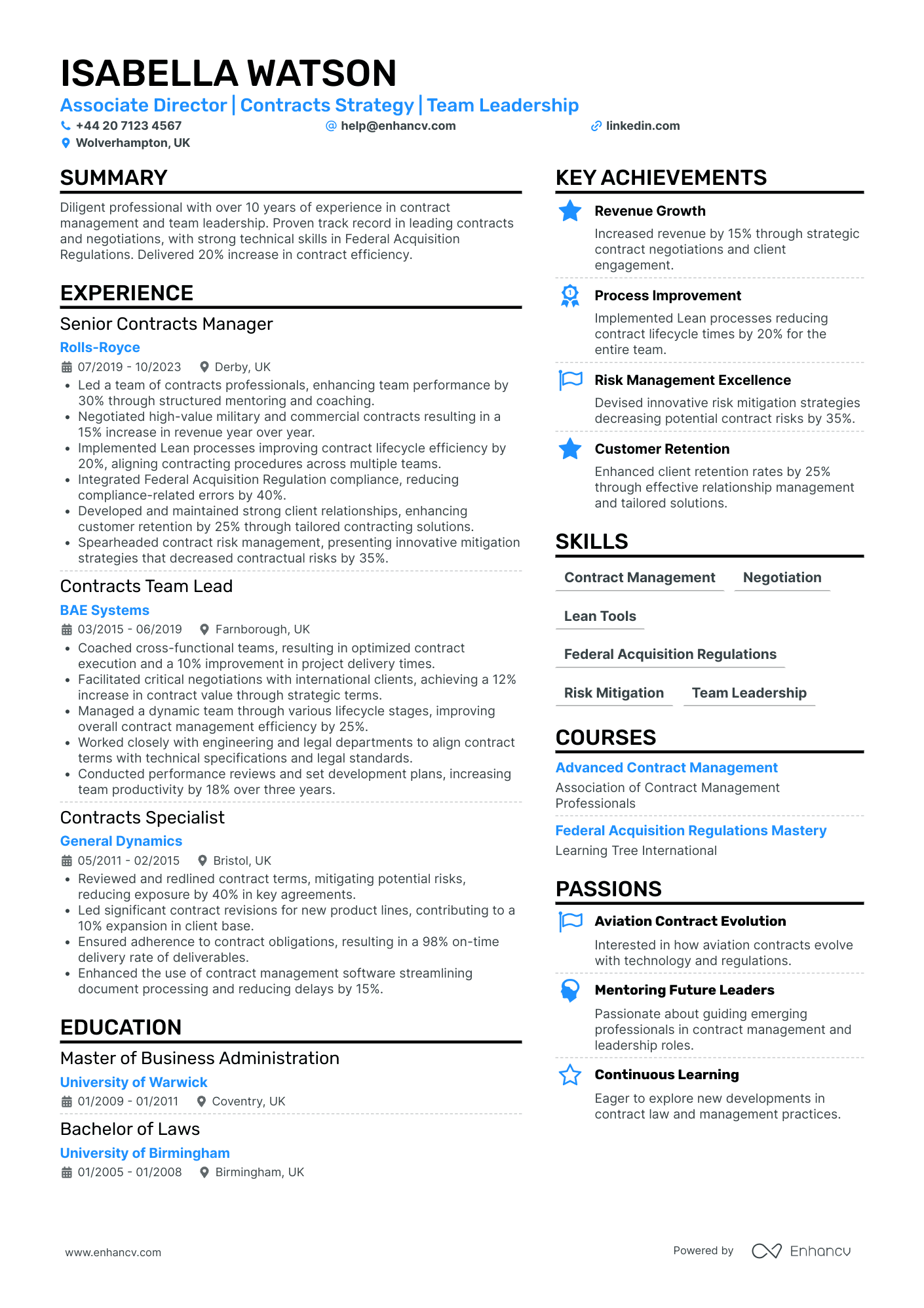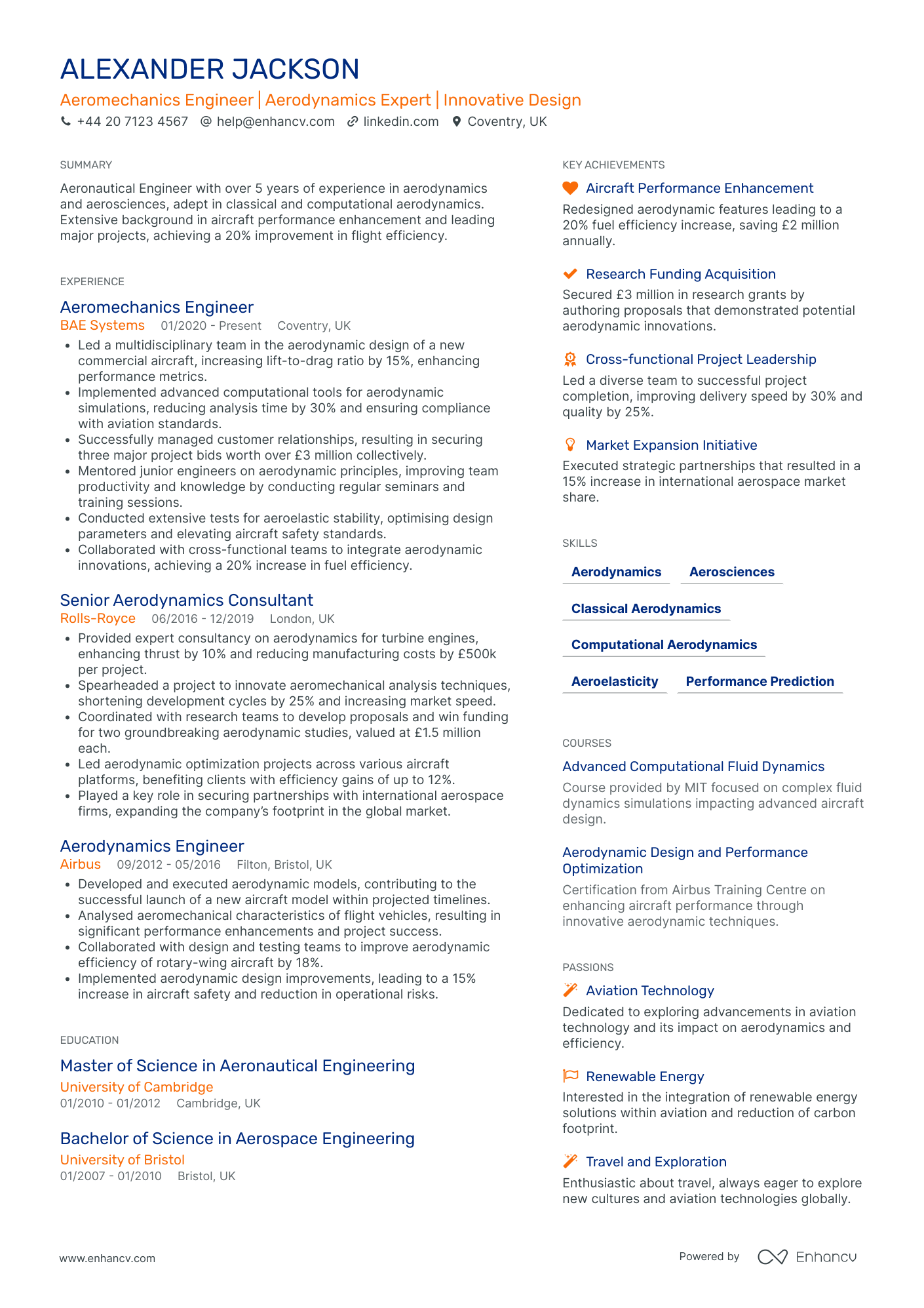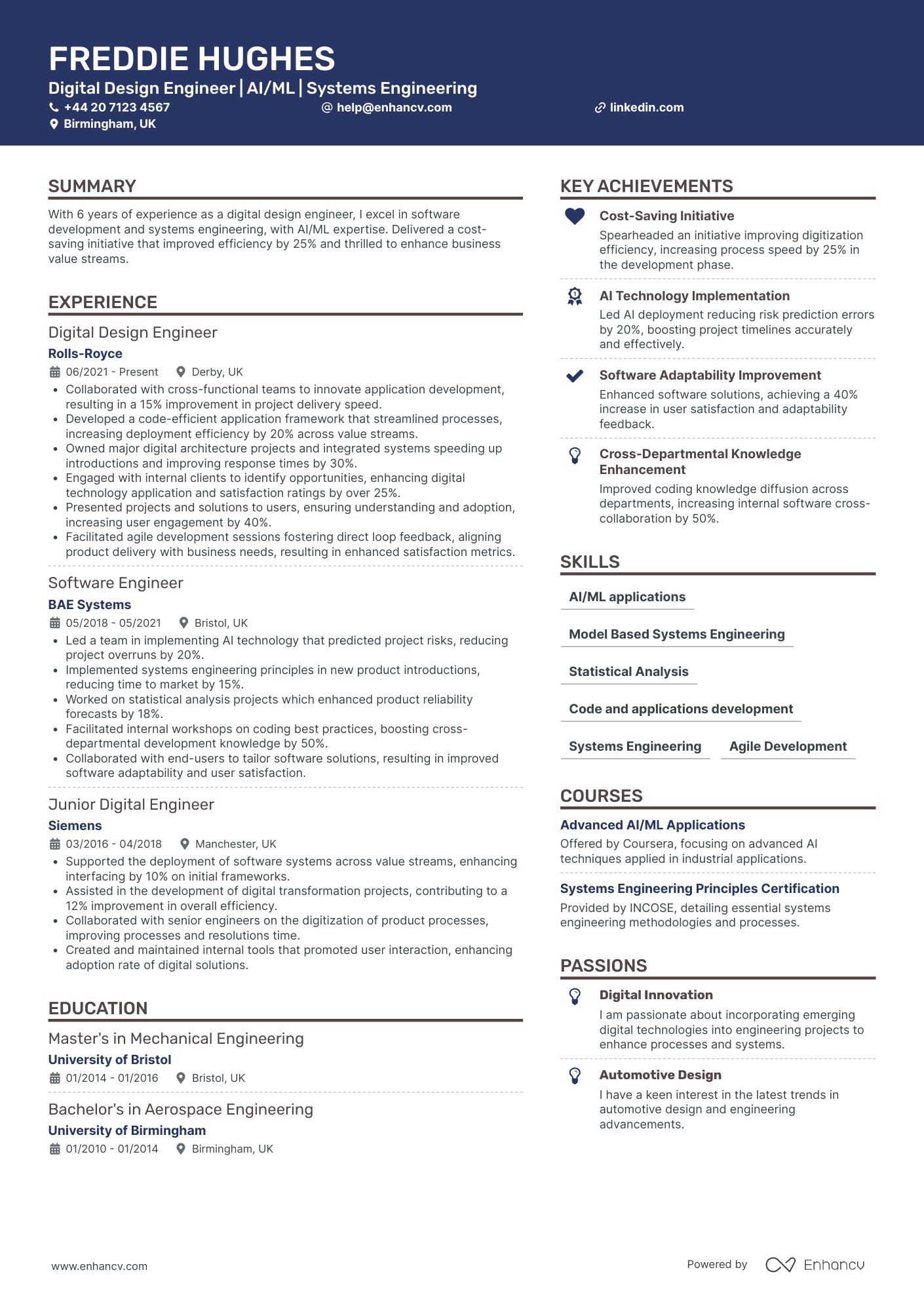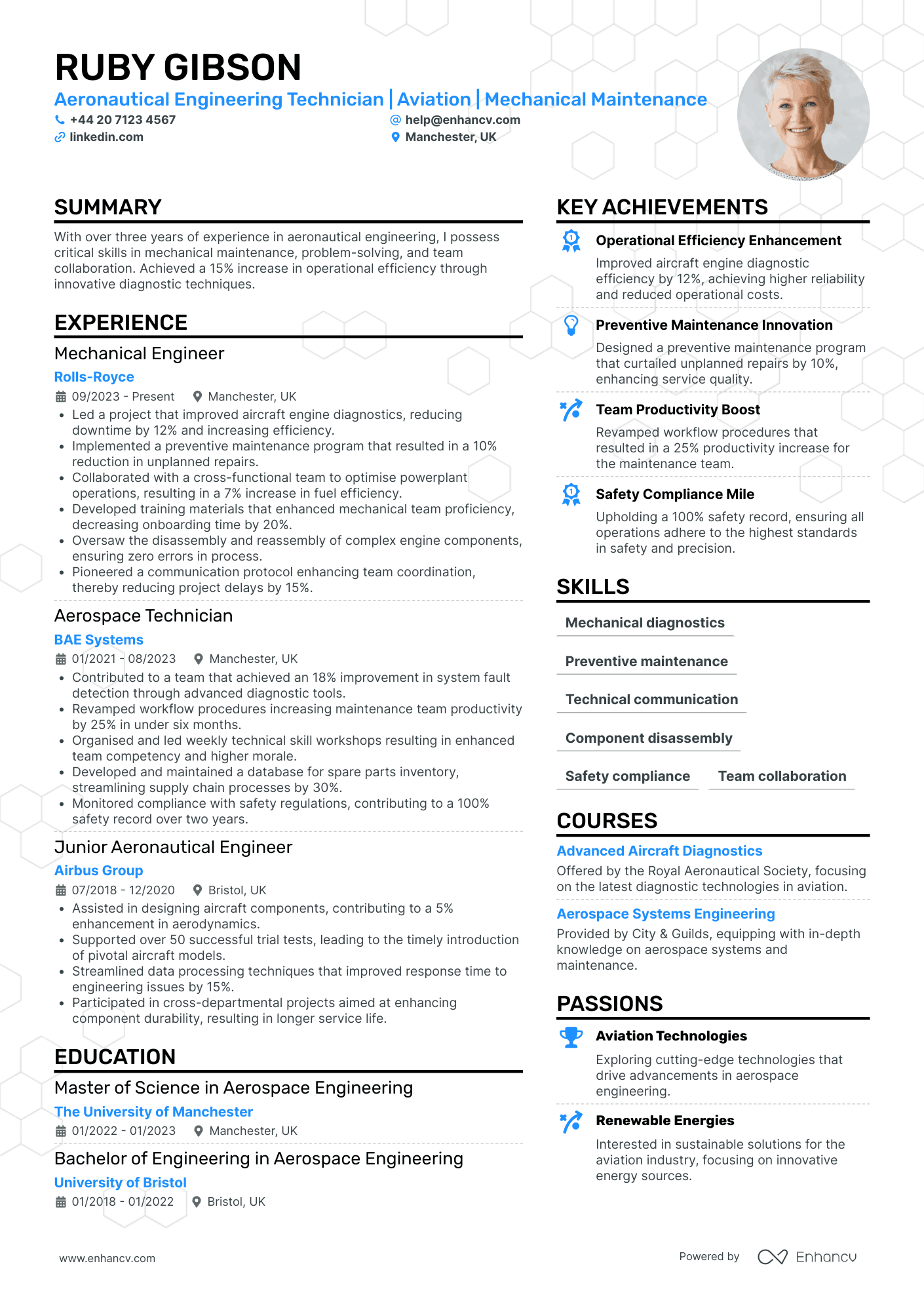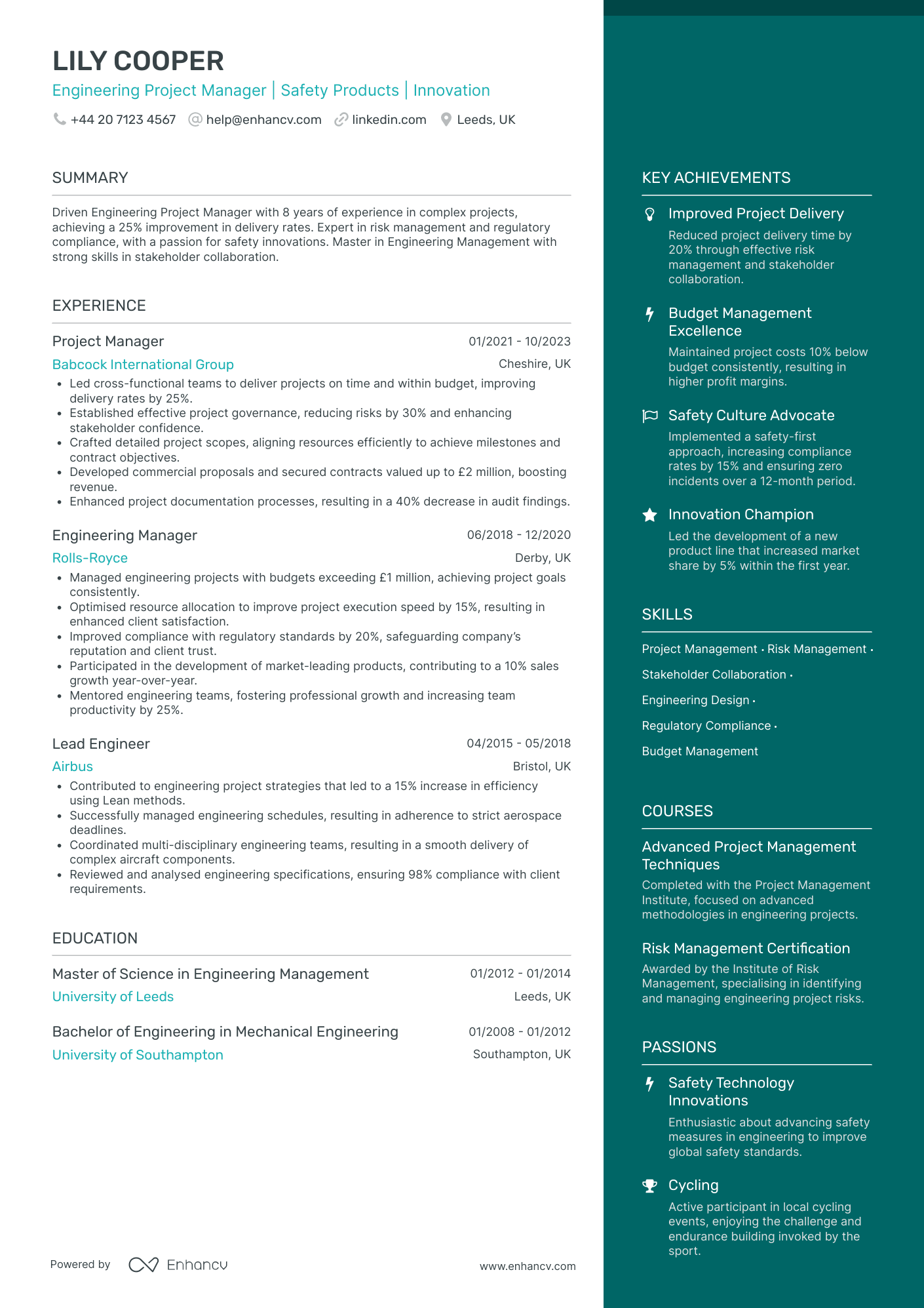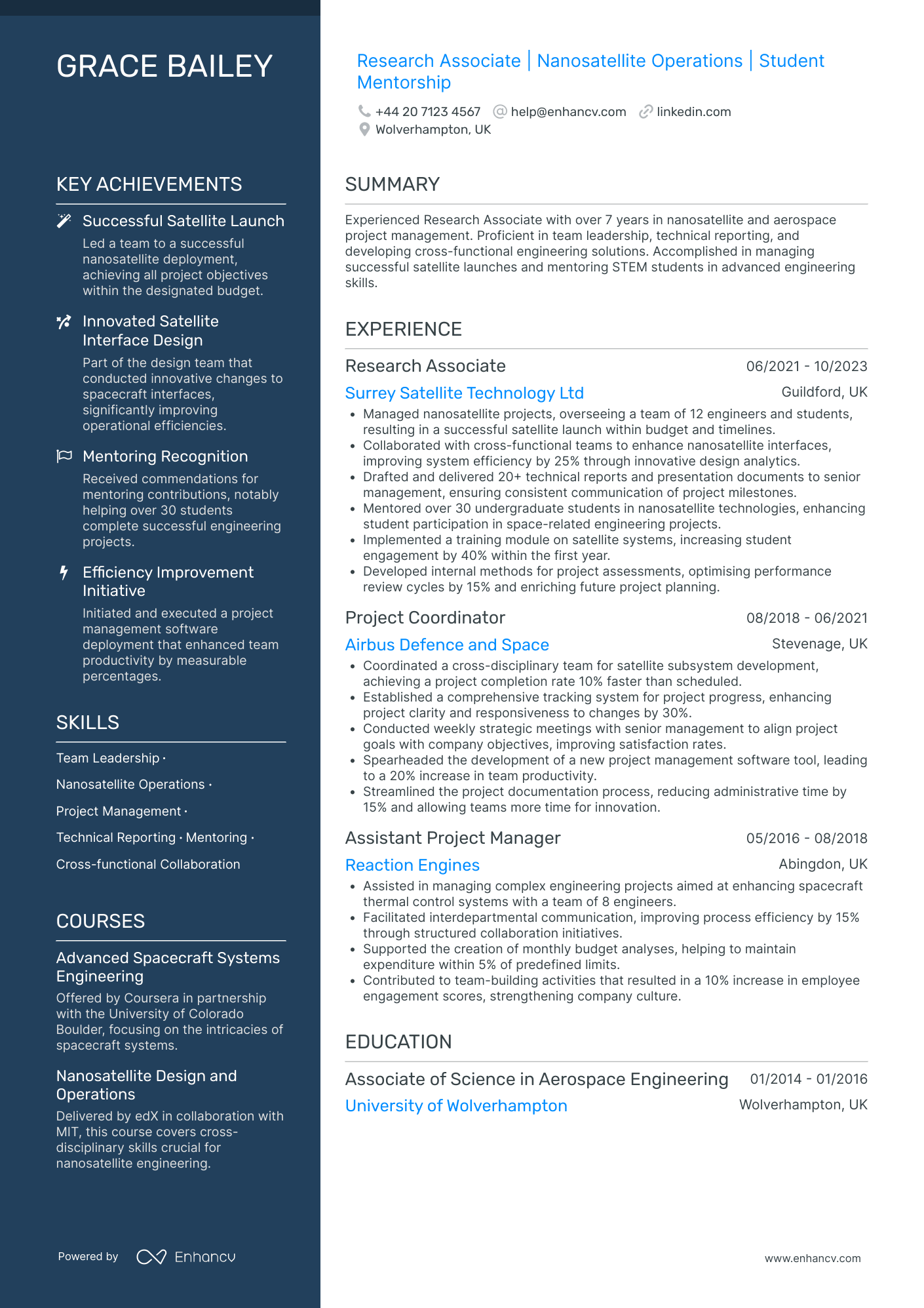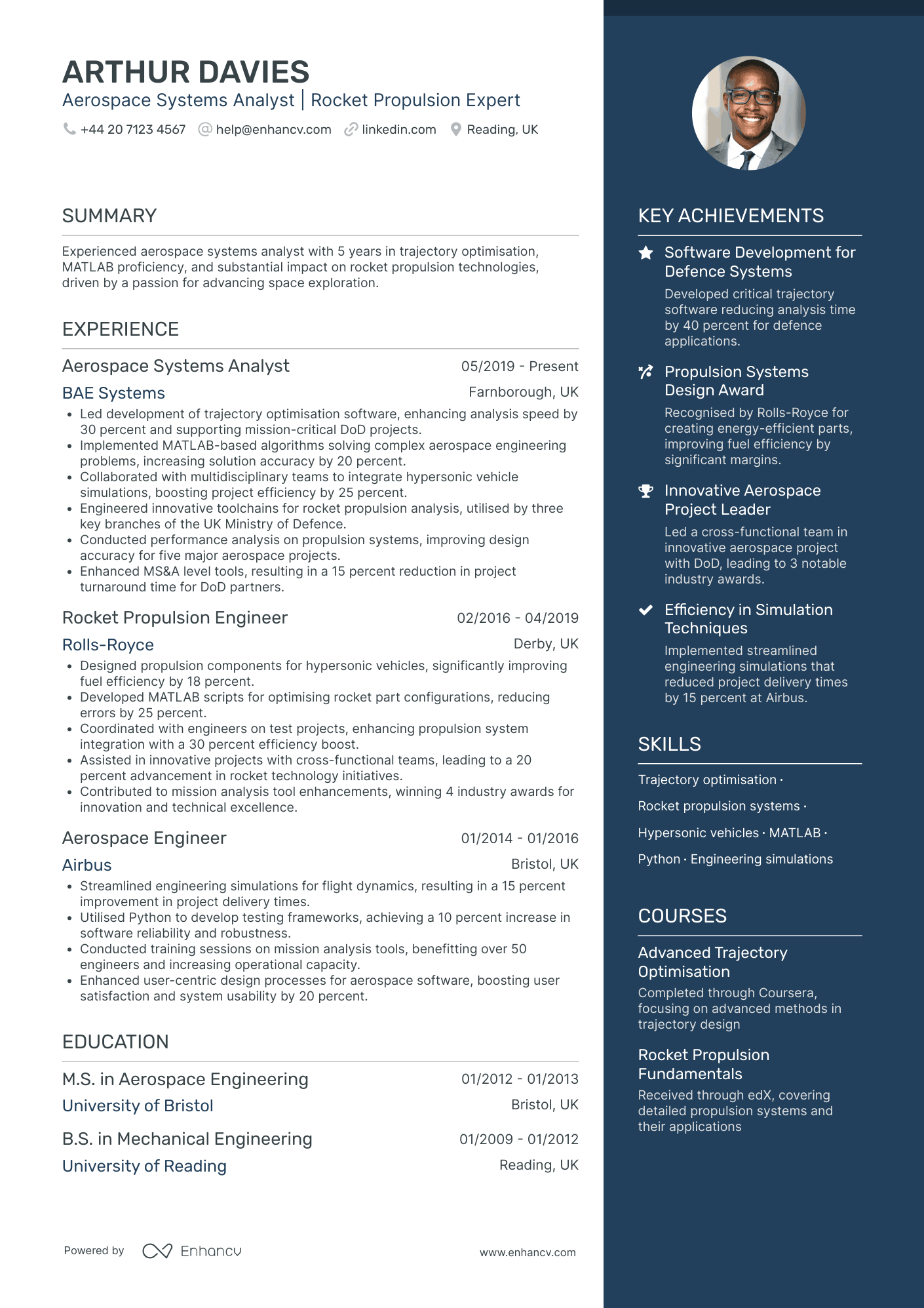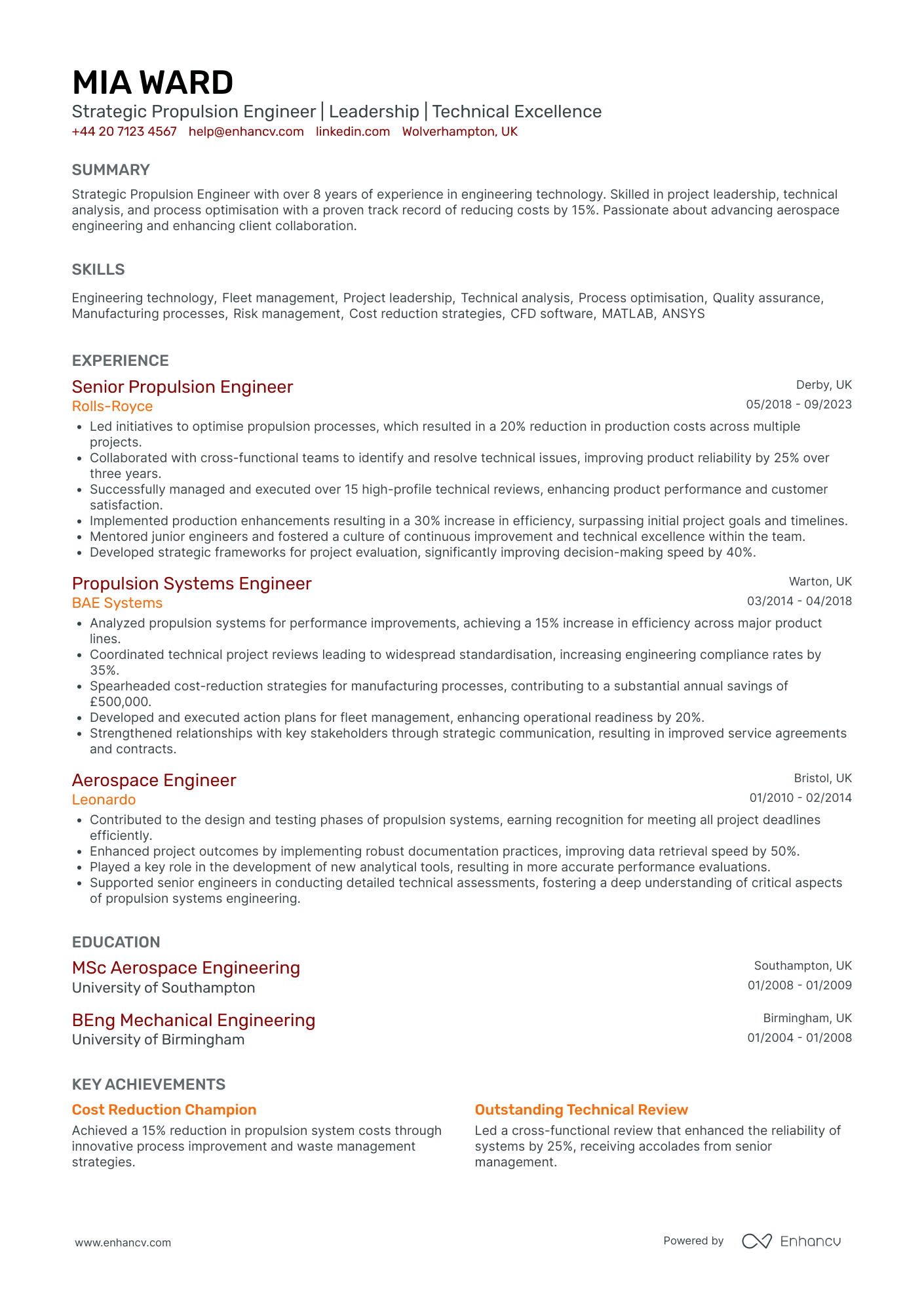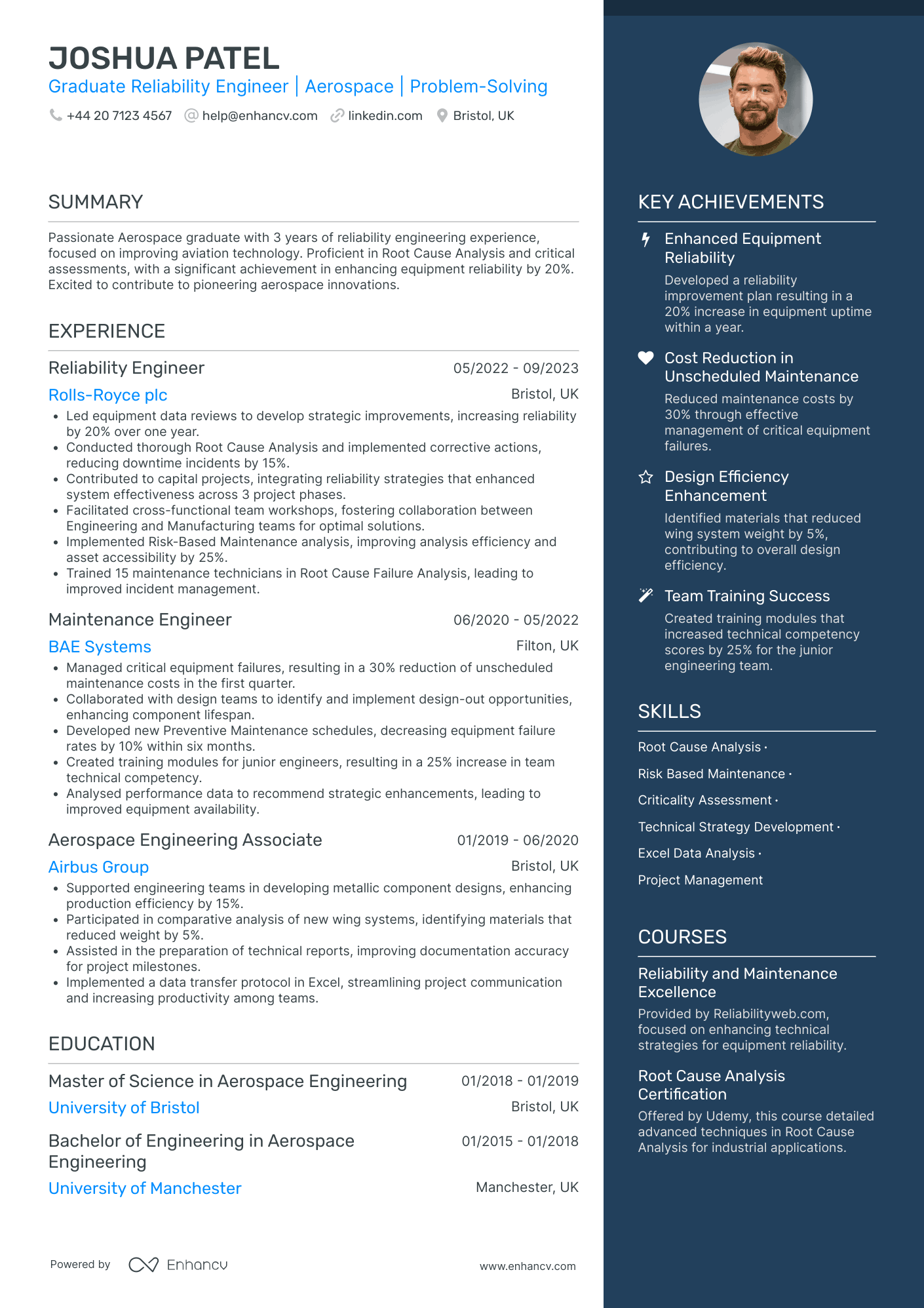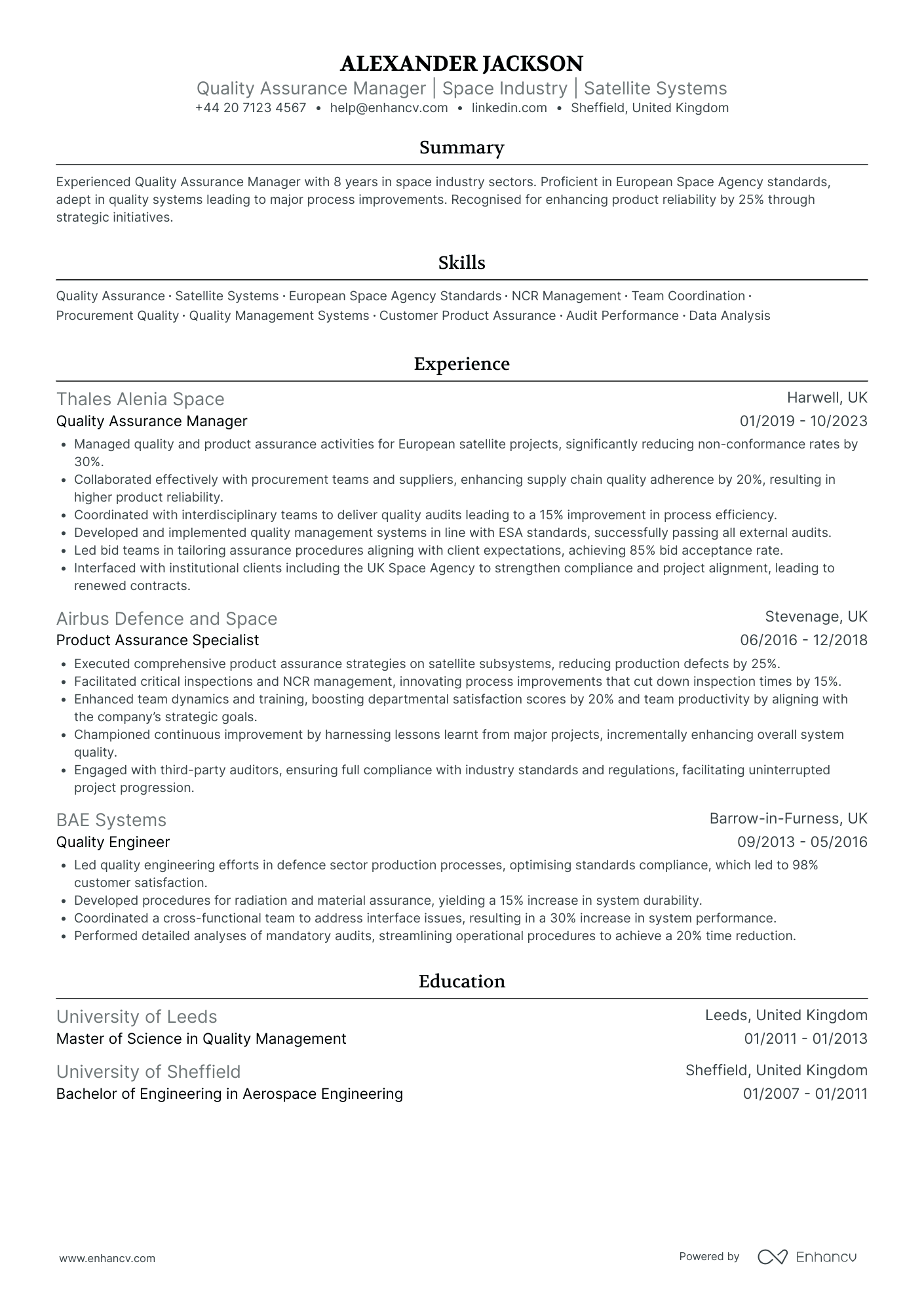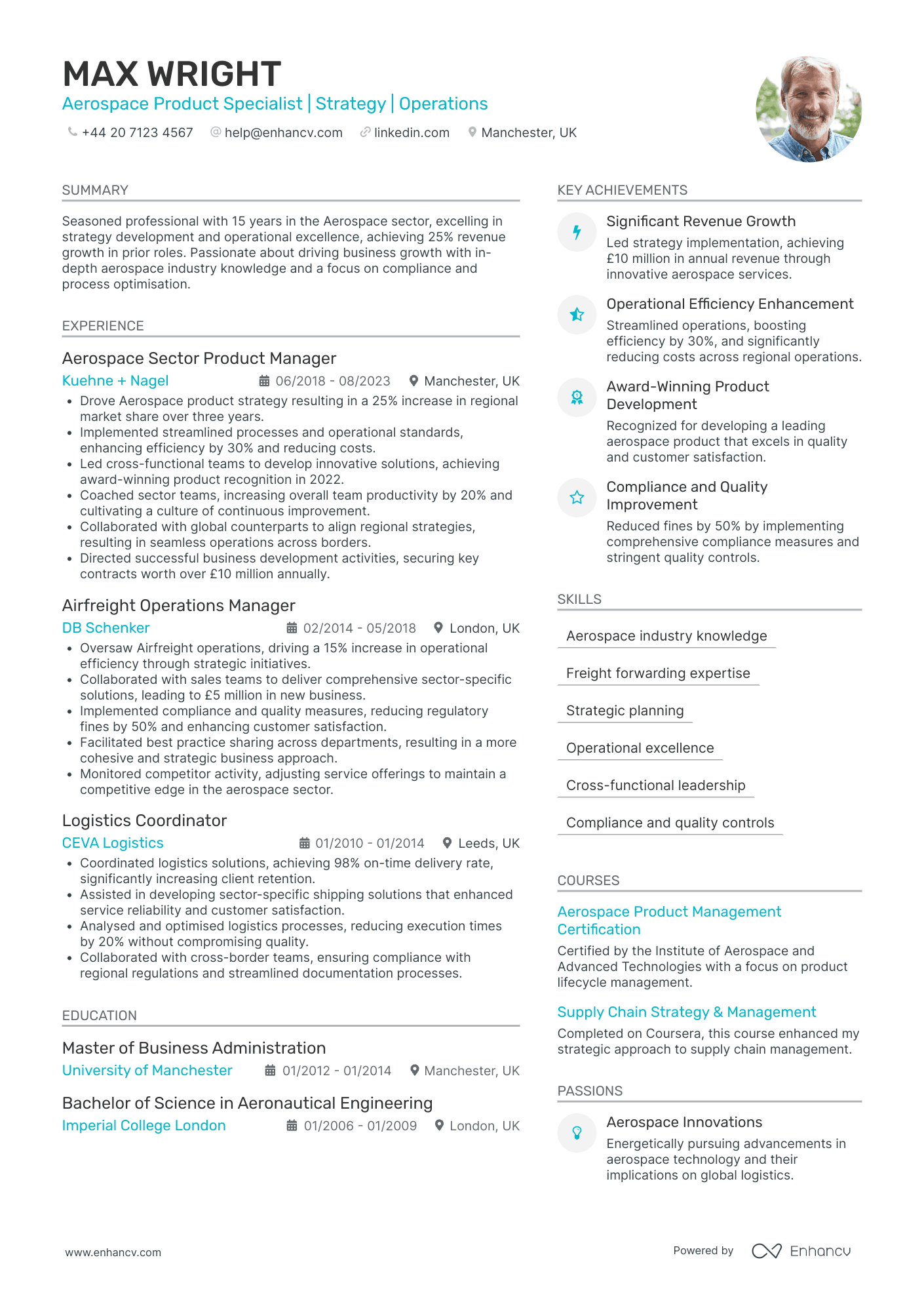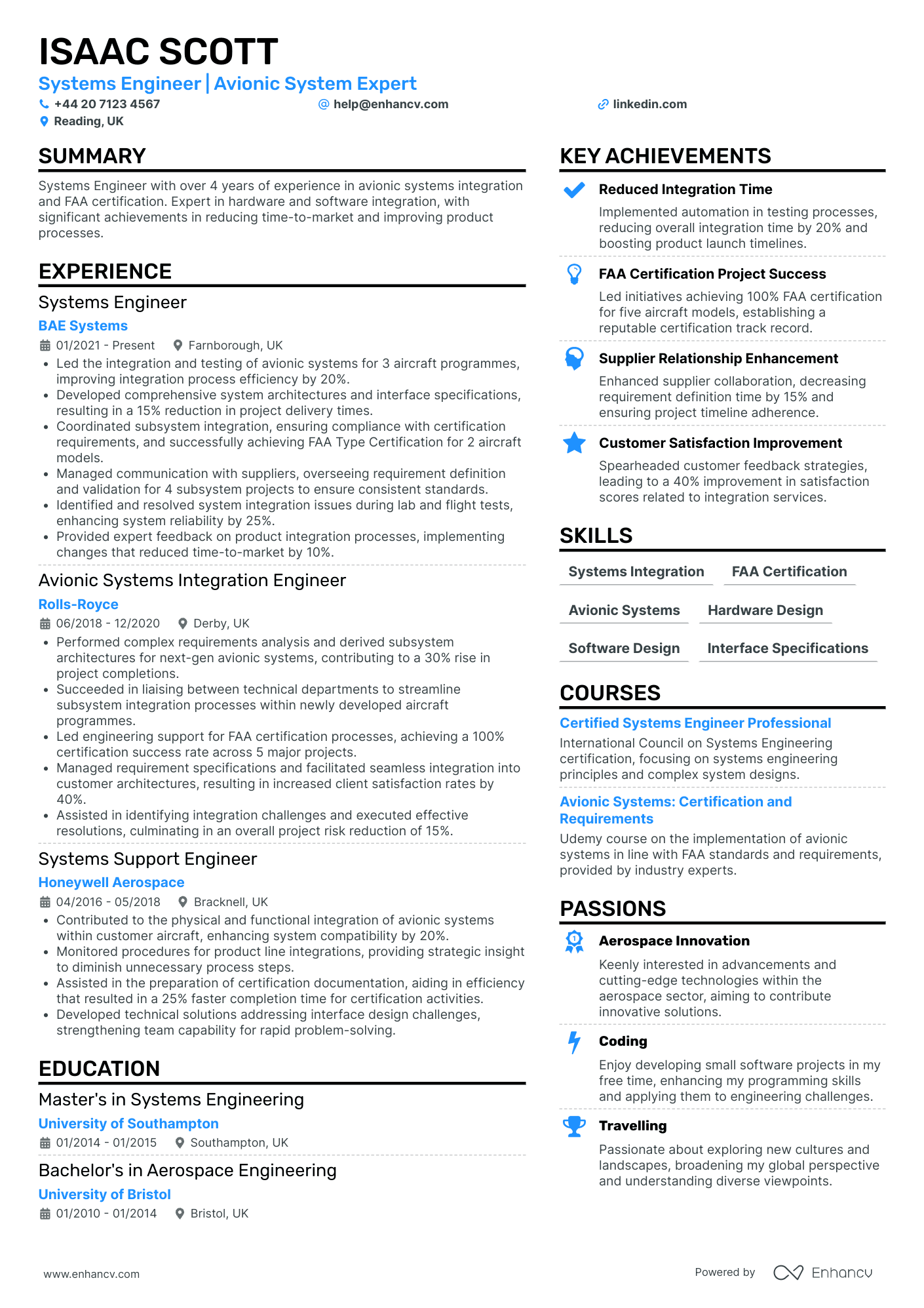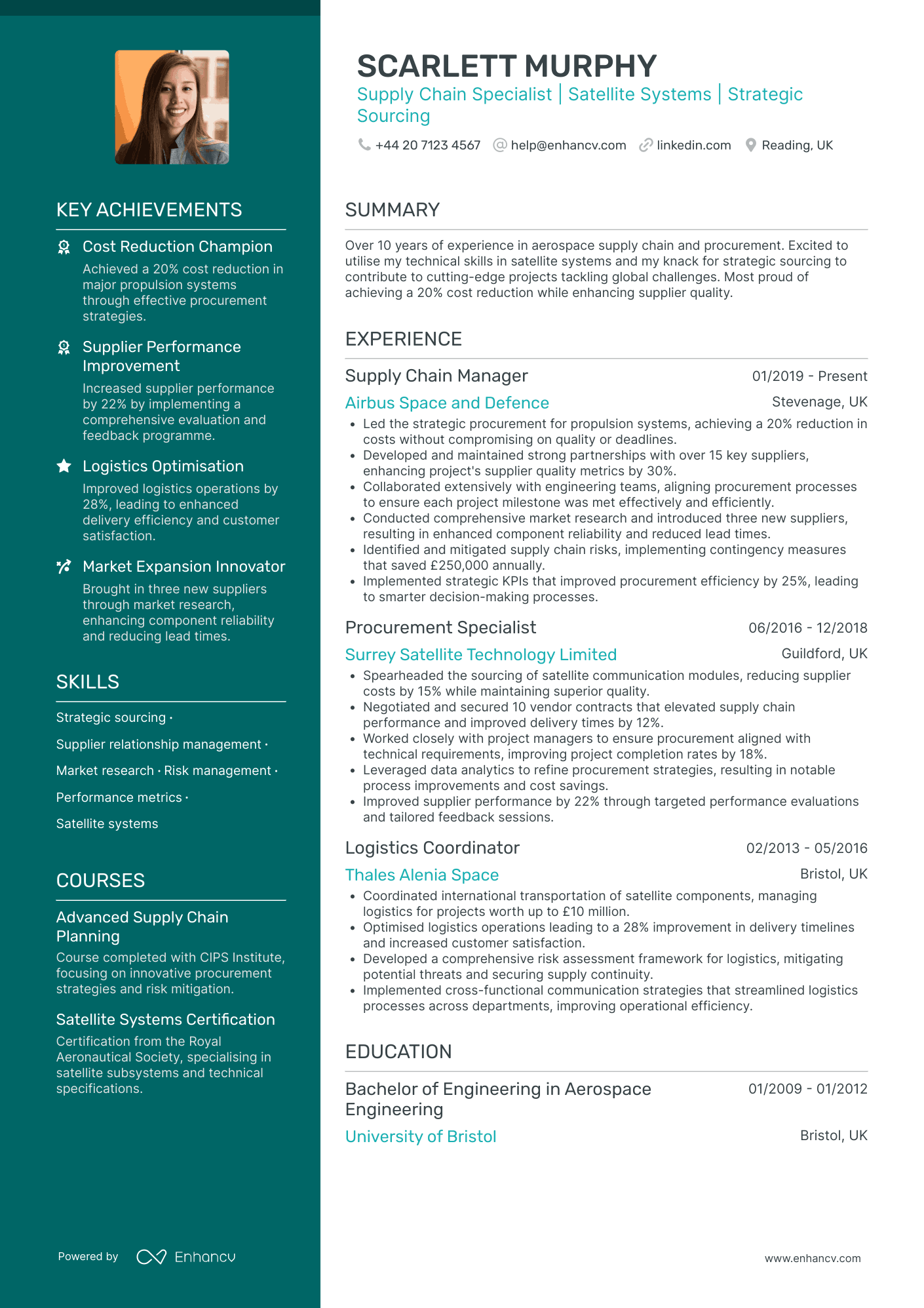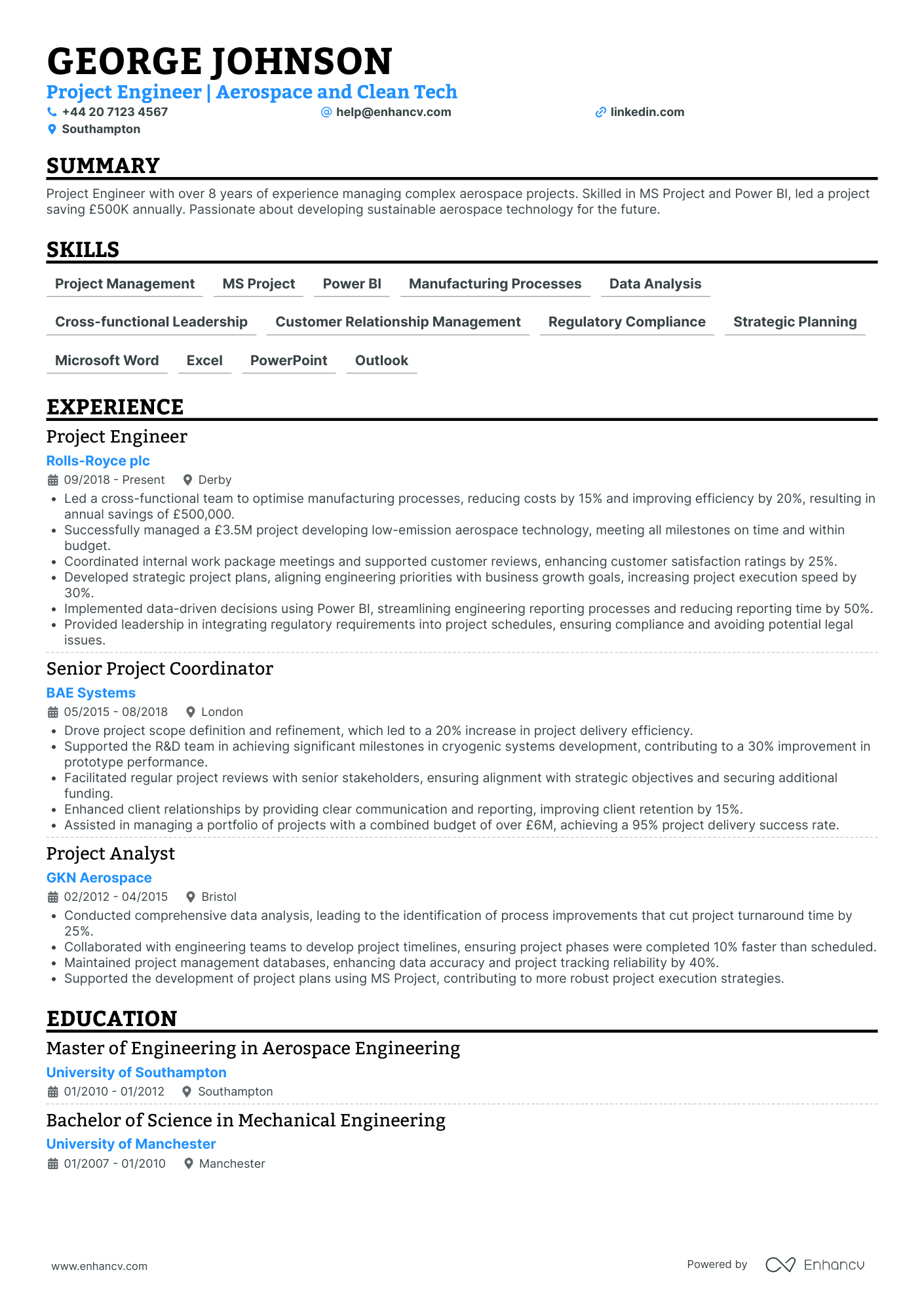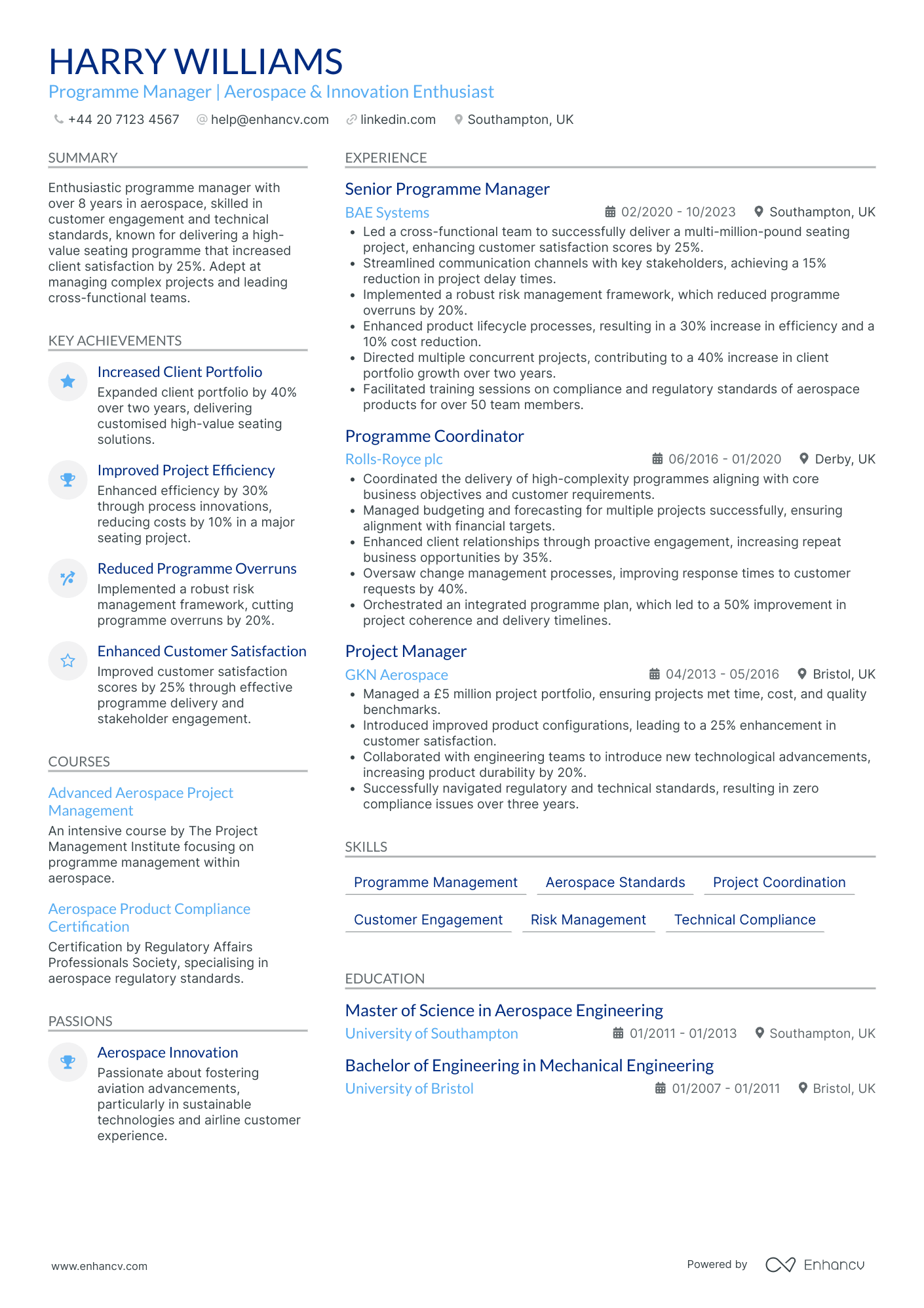One specific CV challenge in aerospace engineering is effectively showcasing complex project experience to non-technical recruiters. Our guide provides clear strategies for translating your technical achievements into engaging narratives that resonate with a broad audience, ensuring your expertise takes centre stage.
- Create an attention-grabbing header that integrates keywords and includes all vital information;
- Add strong action verbs and skills in your experience section, and get inspired by real-world professionals;
- List your education and relevant certification to fill in the gaps in your career history;
- Integrate both hard and soft skills all through your CV.
Discover more industry-specific guides to help you apply for any role in the links below:
CV examples for aerospace engineering
By Experience
Senior Aerospace Engineering Consultant
- Structured and focused content presentation - The CV excels in presenting content clearly and concisely, with well-defined sections that make it easy to navigate. Each part of the CV logically flows from professional summary to detailed experience and achievements, ensuring recruiters can quickly grasp the candidate's qualifications and impact in the aerospace industry.
- Strong representation of career growth - Isaac Scott's CV reflects a clear career trajectory within the aerospace sector, showcasing a progression from Compliance Engineer to Senior Certification Consultant. This advancement demonstrates not only increasing responsibilities but also his ability to drive innovation and efficiency within major aerospace organizations like BAE Systems and Rolls-Royce.
- Impressive technical depth and industry-specific expertise - The CV highlights Isaac's command of aerospace standards and certification processes, emphasizing his expertise in the Military Air System Certification Process and Defence Standard 00-970. His role in leading airworthiness assessments and managing compliance projects underlines his comprehensive understanding of complex aviation systems.
Aerospace Systems Engineering Lead
- Clear Structure and Conciseness - The CV is well-structured, presenting information in a clear manner that ensures ease of reading. Each section is distinctly separated and comprises concise bullet points that communicate key achievements and responsibilities effectively, maintaining the reader's focus on impactful highlights.
- Progressive Career Trajectory - Louis Wood's career demonstrates a strong trajectory, moving from a Junior Systems Engineer to a Senior role within leading defence companies. This progression underscores a continuous development of skills and responsibilities, indicative of his professional growth and capacity to handle increased challenges in systems engineering.
- Advanced Tool Proficiency and Technical Depth - The CV emphasizes industry-specific expertise through detailed mentions of tools like DOORS and Polarion, essential to requirements management in defence systems. This technical depth is augmented by certifications such as the Siemens Polarion program, highlighting a commitment to maintaining high standards in engineering practices.
Principal Aerospace Engineer
- Structured progression through key engineering roles - The CV showcases Joshua Patel's career progression from a Component Engineer to a Principal Obsolescence Engineer. This trajectory highlights his growth in leadership and technical expertise, marked by promotions in prestigious companies such as Thales Group, Raytheon Technologies, and BAE Systems.
- Emphasis on specialized tools and methodologies - The document underscores Joshua's proficiency with industry-standard tools used for obsolescence reviews and component engineering. This technical depth is crucial in demonstrating his capability to enhance product lifecycle management and manage component databases effectively.
- Achievements underscoring tangible business impact - Joshua Patel's CV articulates achievements that align with critical business outcomes. It details how he improved supply chain efficiency by 15% and reduced procurement costs through strategic obsolescence management, highlighting his role in optimizing operational processes.
Aerospace Engineering Operations Manager
- Strategic Career Advancement - Samuel Campbell's CV reflects a methodical career progression in the manufacturing sector, marked by significant roles at leading aerospace and defense companies. He has moved from a Supply Chain Specialist to Operations Manager, showcasing growth in responsibility and expertise, particularly in applying lean principles and enhancing operational efficiencies across organizations.
- Mastery of Lean Principles - A standout feature is Samuel's deep expertise in lean manufacturing and project management, as seen in his roles that have consistently driven efficiency improvements. His efforts at companies like Rolls-Royce and Airbus have resulted in significant waste reduction and cost savings, attesting to his technical acumen and industry-specific mastery.
- Leadership and Cross-Functional Collaboration - The CV emphasizes Samuel's leadership qualities, with notable achievements in leading cross-departmental teams and spearheading initiatives that align supply chain and production strategies. His role in SIOP processes and regulatory audits underscores his ability to foster collaboration, manage complex projects, and achieve organizational goals effectively.
Aerospace Engineering Intern
- Comprehensive Content Presentation - The CV is structured clearly, with well-defined sections that make it easy for potential employers to quickly identify key information. Each section is concise and focused, highlighting only the most relevant experiences and skills, which ensures clarity and facilitates quick reading.
- Strategic Career Development - Rosie Gray's career trajectory demonstrates strategic growth and adaptation. Gaining experience with companies like Rolls-Royce and BAE Systems shows a focus on gaining industry-specific experience in experimental simulations and engineering analysis, aligning directly with her aspirations in mechanical engineering.
- Innovative Use of Industry Tools and Techniques - The CV emphasizes unique industry-specific elements, such as direct numerical simulations and linear stability theory. By highlighting her proficiency in Matlab, Python, and C++, it underscores her technical depth and readiness to tackle complex engineering challenges.
Aerospace Engineering Director
- Structured Presentation - The CV is organized with clear sections such as Summary, Experience, Education, and Skills, which enhances readability and allows the hiring manager to easily identify key qualifications relevant to the desired role in contract management and leadership.
- Consistent Career Advancement - Isabella's career path demonstrates a clear trajectory of growth from Contracts Specialist to Associate Director over a decade. The transitions reflect consistent promotions within prestigious companies like Rolls-Royce and BAE Systems, indicating her increasing responsibility and leadership in the field.
- Industry-Specific Expertise - The CV emphasizes Isabella's proficiency in specific methodologies such as Lean processes and Federal Acquisition Regulations, showcasing technical depth. Her ability to integrate these elements has led to significant improvements in contract efficiency and compliance, key competencies in contract management roles.
Entry-Level Aerospace Engineer
- Comprehensive career progression - Alexander Jackson's CV showcases a clear upward trajectory in his professional journey from an Aerodynamics Engineer to an Aeromechanics Engineer, with escalating responsibilities and roles at prestigious companies like Airbus, Rolls-Royce, and BAE Systems. Such growth underlines his commitment and proven expertise in the aerodynamics field.
- Rich technical depth and tool utilization - The CV highlights Alexander's proficiency in industry-specific methodologies such as Computational Fluid Dynamics (CFD), ANSYS Fluent, and MATLAB, illustrating a robust command over advanced aerodynamics tools. This technical acumen is crucial for staying competitive and innovative in the aerodynamics engineering sector.
- Strategic and impactful achievements - Alexander's significant accomplishments, like enhancing aircraft fuel efficiency by 20% and securing high-value project bids, stand out. These achievements underscore his ability to convert technical expertise into business value, showcasing how his contributions directly correlate with substantial financial savings and market gains for his employers.
Aerospace Engineering Design Manager
- Career Progression in Renowned Companies - This CV traces a robust career path through leading engineering firms like Rolls-Royce, BAE Systems, and Siemens. It highlights growth from a Junior Digital Engineer to a Digital Design Engineer, showcasing a steady progression and increased responsibility in complex engineering environments.
- Integration of Technical Expertise with Business Impact - The CV excels in blending technical achievements with business results, demonstrating not only the candidate's engineering proficiency but the tangible business benefits achieved. Innovations in application frameworks and AI have led to significant time and cost savings, thereby enhancing efficiencies and user satisfaction rates considerably.
- Comprehensive Inclusion of Diverse Experience - A well-structured CV, it includes sections on education, skills, additional certifications, achievements, and languages, each relevant to the role of a Digital Design Engineer. This structured presentation paints a complete picture of a multifaceted professional, prepared to tackle diverse challenges in digital systems and AI applications.
By Role
Aerospace Engineering Technician
- Structured and Cohesive Presentation - The CV is structured with a well-defined format that effectively separates each section, making it easy for readers to follow the candidate's career journey and qualifications. The use of bullet points for achievements and experiences enhances clarity and ensures conciseness, presenting complex information succinctly.
- Impressive Career Trajectory - Ruby Gibson’s career path clearly illustrates a progressive growth within the aeronautical engineering field. The advancement from a Junior Aeronautical Engineer to a Mechanical Engineer at Rolls-Royce signifies substantial professional development and increased responsibility, indicative of her capability and ambition within the industry.
- Technical Depth with Industry-Specific Tools - The CV highlights proficiency in advanced diagnostic tools and methodologies specific to the aeronautical industry. Ruby’s experience with preventive maintenance and complex engine diagnostics reflects a deep technical understanding pertinent to her role, demonstrating her ability to leverage industry-specific knowledge effectively.
Aerospace Engineering Project Manager
- Structured and Focused Content Presentation - The CV is well-organized, beginning with a clear header and summary that succinctly outlines Lily Cooper's professional focus. Each section is logically structured, presenting a coherent and concise narrative of her career development, from education to experience, ensuring that all essential information is easily accessible and understandable.
- Progressive Career Trajectory - Lily's career path demonstrates significant growth, advancing from a Lead Engineer to Engineering Manager, and ultimately Project Manager. Her trajectory shows a steady accumulation of responsibilities and leadership roles, reflecting her ability to adapt and excel in more complex and strategic positions within the engineering sector.
- Emphasis on Unique Industry-Specific Achievements - The CV highlights specific methodologies and strategies, such as Lean Manufacturing and effective project governance, which not only align with industry standards but also signal Lily's proficiency in applying these methods to drive project success. Her achievements in enhancing delivery rates and reducing project risks are particularly significant within the highly technical and safety-critical engineering field.
Aerospace Engineering Research Associate
- Comprehensive Career Trajectory - Grace Bailey's CV clearly outlines a progressive career in aerospace, showing growth from an Assistant Project Manager to a Research Associate. Each position indicates not only a step up in responsibility but also the development of specialized skills in nanosatellite operations and project management.
- Technical Depth and Innovation - The CV highlights industry-specific elements such as the management of nanosatellite projects and the improvement of satellite interfaces. These showcase highly specialized knowledge in aerospace engineering and demonstrate Bailey's capability in driving innovation and efficiency within the space sector.
- Leadership and Mentorship - A strong focus on soft skills, especially leadership and mentorship, is evident throughout the document. Bailey's experience mentoring over 30 students and enhancing student participation in engineering projects shows a commitment to developing future talent while also strengthening her leadership credentials.
Aerospace Engineering Analyst
- Clear structure and concise presentation - The CV uses an organized structure with distinct sections, making information easy to locate and digest. Bullet points in the experience section provide concise highlights of responsibilities and achievements, each emphasizing quantitative improvements that aid in quick assimilation.
- Consistent career growth and specialization - Arthur's career trajectory shows a continuous progression in roles from Aerospace Engineer to Systems Analyst, with an evident deepening focus on aerospace systems and rocket propulsion. This trajectory highlights both personal growth within the field and steady advancement aligned with industry demands.
- Agility in cross-disciplinary collaboration - Arthur's roles reveal a strong ability to work across different domains, exemplifying adaptability and the ability to lead innovative projects that integrate multiple engineering disciplines. His experience in fostering cross-functional collaboration ensures integrative solutions in complex projects.
Aerospace Propulsion Engineer
- Exceptional Technical Depth in Engineering Tools and Methodologies - Mia Ward's CV comprehensively covers her proficiency in critical engineering tools such as CFD software, MATLAB, and ANSYS. Her expertise showcases her capability to perform advanced technical analysis and contribute significantly to engineering projects, underlining extensive technical depth within the aerospace domain.
- Impressive Career Trajectory Highlighting Leadership and Innovation - Ward's career progression from Aerospace Engineer to Senior Propulsion Engineer shows a clear growth in leadership and responsibility. Her advancement reflects her strategic impact on projects at giants like Rolls-Royce and BAE Systems, showcasing successful shifts into roles demanding greater oversight and strategic influence.
- Noteworthy Achievements with Tangible Business Impact - The CV features achievements that are not only quantified but also demonstrate substantial business relevance. For instance, she led projects that brought about a 20% cost reduction and a 25% improvement in product reliability. These accomplishments highlight her ability to drive efficiency and ensure customer satisfaction, contributing directly to organizational success.
Aerospace Structural Engineer
- Clarity and Structured Presentation - Joshua Patel’s CV is highly organized and succinct, making it easy to navigate through his educational background, work experience, skills, and achievements. Each section is clearly defined, maintaining conciseness without losing the essence of his capabilities and contributions. This clarity in presentation ensures that potential employers can quickly grasp his professional journey and skill sets relevant to a reliability engineer role.
- Career Growth in Aerospace Engineering - The CV presents a clear trajectory of professional growth, detailing Joshua's advancement from an Aerospace Engineering Associate at Airbus Group to a Reliability Engineer at Rolls-Royce plc. His career path illustrates a deepening expertise in reliability engineering and increasing responsibility, with each role contributing to key aerospace projects and technical developments in the industry.
- Significant Achievements and Business Impact - Joshua's achievements are not only detailed with quantifiable results but also emphasize their wider business impact. For example, the 20% increase in equipment reliability and a 30% reduction in unscheduled maintenance costs are not just numbers but reflect substantial organizational improvements that hint at cost savings and enhanced operational efficiency. These points clearly position Joshua as a contributor to impactful aerospace innovations.
Aerospace Engineering Quality Assurance Manager
- Structured and Concise Presentation - The CV is well-organized with clear headings and bullet points that enhance readability. Each section is methodically structured, providing concise yet comprehensive information which allows easy navigation through the content, facilitating quick comprehension of the candidate's experience and skills.
- Strong Career Trajectory in the Space Industry - Alexander Jackson's career path demonstrates significant growth within the space industry. His progression from a Quality Engineer to a Quality Assurance Manager illustrates a path of increasing responsibility and influence, indicative of his ability to grow and adapt in a high-tech industry.
- Specialized Industry-Specific Expertise - The candidate showcases a deep technical depth with specific expertise in European Space Agency standards and satellite systems. His ability to lead quality assurance in a highly specialized field aligns well with the demands of the space industry, emphasizing both his technical prowess and commitment to stringent quality standards.
Aerospace Engineering Department Head
- Clear and Logical Content Structure - The CV is skillfully structured with distinct sections such as Experience, Education, Skills, and Achievements, allowing readers to quickly comprehend key information. The use of bullet points for each position supports easy readability and ensures that the content remains concise while effectively communicating the candidate's professional journey and expertise.
- Demonstrated Career Growth and Industry Expertise - Max Wright’s career trajectory showcases a steady rise from a Logistics Coordinator to an Aerospace Sector Product Manager, indicating a solid progression in responsibilities and impact within the aerospace industry. This growth is punctuated by valuable experience in different roles, each building upon the former, cementing Max as a seasoned expert in both strategy and operations.
- Focus on Strategic and Operational Excellence - The CV highlights significant achievements that are particularly relevant to the aerospace sector, such as implementing streamlined processes that improved efficiency by 30% and leading cross-functional teams to develop award-winning products. These achievements not only demonstrate technical competency but also illustrate Max's ability to impact business operations and revenue positively.
Aerospace Flight Systems Engineer
- Concise and Structured Presentation - The CV is well-organized, with each section clearly delineated and easy to navigate. Information is presented concisely, allowing quick comprehension of the candidate's qualifications and experience. The use of bullet points in the experience section effectively highlights key achievements and responsibilities, ensuring clarity in content delivery.
- Strong Career Progression - Isaac Scott’s career shows a clear growth trajectory within the aerospace and defense industry, moving from a Systems Support Engineer to a Systems Engineer role. This progression illustrates an increasing level of responsibility and expertise, with a shift towards integration leadership and certification processes, which aligns well with his specialization in avionic systems.
- Technical Expertise and Certifications - The CV showcases a robust technical foundation in avionic systems, underpinned by relevant certifications and advanced educational qualifications. This includes comprehensive knowledge of FAA certification processes and proficiency in industry-standard tools like MATLAB, Simulink, and CAD tools, highlighting his technical depth in systems engineering.
Aerospace Engineering Procurement Specialist
- Career Development and Industry Expertise - Scarlett Murphy's CV illustrates a progressive career trajectory within the aerospace sector, highlighting growth from a Logistics Coordinator to a Supply Chain Manager at prestigious companies like Airbus Space and Defence. Her experiences emphasize a deep understanding and expertise in the niche field of satellite systems sourcing, reflecting both her upward career mobility and specialization in strategic sourcing.
- Technical Acumen and Strategic Sourcing Skills - This CV effectively demonstrates Murphy's strong technical background in aerospace engineering alongside her strategic procurement skills. Her achievements in reducing costs, improving supplier quality, and refining procurement strategies through data analytics underscore her technical depth and industry-specific knowledge, which are critical for a Supply Chain Specialist in satellite systems.
- Structured Content Presentation with Evident Impact - The CV is well-structured, presenting information succinctly with clear headings and bullet points that aid readability. Each section provides precise details of her accomplishments, such as improving delivery times by 12% and procurement efficiency by 25%, obtaining measurable results that indicate significant business impact in her roles.
Aerospace Engineering Product Development Engineer
- Clear and Concise Presentation - The CV is structured efficiently, presenting George's experience, achievements, and skills in a logical manner. Each section is clearly defined, utilizing bullet points for key responsibilities and accomplishments, ensuring quick readability and comprehension.
- Progressive Career Trajectory - George's career exhibits steady advancement from a Project Analyst to a Project Engineer role, demonstrating consistent growth within the aerospace industry. This progression, coupled with increasing responsibilities, highlights his capabilities and ambition in driving complex engineering projects.
- Industry-Specific Tools and Technical Expertise - The CV emphasizes George's proficiency with aerospace-specific tools and methodologies, such as MS Project and Power BI, underscoring his technical depth. His experience in managing high-value, low-emission technology projects reflects niche expertise within sustainable aviation and clean tech.
Aerospace Engineering Programme Manager
- Structured Content Presentation - The CV is well-organized, providing clear sections that cover key areas such as experience, education, and skills. The concise bullet points under each experience entry allow for easy scanning, making it simple for readers to quickly grasp the candidate's key responsibilities and achievements.
- Impressive Career Trajectory - Harry Williams has shown steady growth in his career from a Project Manager to a Senior Programme Manager. This progression not only demonstrates his capability and competence in his field but also highlights his dedication to advancing within the aerospace industry.
- Impactful Achievements with Business Relevance - The CV goes beyond listing accomplishments by linking them to business outcomes. For instance, increasing client satisfaction scores by 25% and expanding portfolio growth by 40% are achievements that directly relate to business success, demonstrating how his work contributes to company goals.
How to ensure your profile stands out with your aerospace engineering CV format
It's sort of a Catch 22. You want your aerospace engineering CV to stand out amongst a pile of candidate profiles, yet you don't want it to be too over the top that it's unreadable. Where is the perfect balance between your CV format simple, while using it to shift the focus to what matters most. That is - your expertise. When creating your aerospace engineering CV:
- list your experience in the reverse chronological order - starting with your latest roles;
- include a header with your professional contact information and - optionally - your photograph;
- organise vital and relevant CV sections - e.g. your experience, skills, summary/ objective, education - closer to the top;
- use no more than two pages to illustrate your professional expertise;
- format your information using plenty of white space and standard (2.54 cm) margins, with colours to accent key information.
Once you've completed your information, export your aerospace engineering CV in PDF, as this format is more likely to stay intact when read by the Applicant Tracker System or the ATS. A few words of advice about the ATS - or the software used to assess your profile:
- Generic fonts, e.g. Arial and Times New Roman, are ATS-compliant, yet many candidates stick with these safe choices. Ensure your CV stands out by using a more modern, and simple, fonts like Lato, Exo 2, Volkhov;
- All serif and sans-serif fonts are ATS-friendly. Avoid the likes of fancy decorative or script typography, as this may render your information to be illegible;
- Both single- and double-column formatted CVs could be assessed by the ATS;
- Integrating simple infographics, icons, and charts across your CV won't hurt your chances during the ATS assessment.

PRO TIP
For certain fields, consider including infographics or visual elements to represent skills or achievements, but ensure they are simple, professional, and enhance rather than clutter the information.
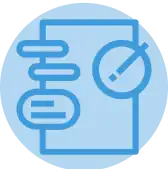
The top sections on a aerospace engineering CV
- Education credentials such as degrees in Aerospace Engineering, to show formal training and knowledge in the field.
- Relevant aerospace experience, to highlight practical skills and previous contributions to the industry.
- Technical proficiency section, to detail specific aerospace tools and software expertise.
- Professional certifications in aerospace, emphasising industry recognition and specialised skills.
- Projects and publications list, demonstrating innovation and thought leadership within aerospace engineering.
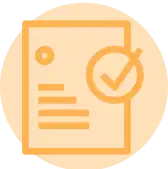
What recruiters value on your CV:
- Highlight any aerospace-specific projects or experience, showing your direct involvement and the impact you had on the project's success.
- Include any relevant certifications, like a Professional Engineer (PE) license or accreditation from the Royal Aeronautical Society, which can set you apart from other candidates.
- Demonstrate your proficiency with industry-standard software tools such as CATIA, SolidWorks, or ANSYS, as these are crucial for designing and simulating aerospace components.
- Emphasise your knowledge of aerospace standards and regulations, such as those from the European Union Aviation Safety Agency (EASA), as familiarity with compliance is essential.
- Detail your experience with systems engineering and integration as aerospace projects often involve complex, interdisciplinary work requiring coordination among various subsystems.
Recommended reads:
How to present your contact details and job keywords in your aerospace engineering CV header
Located at the top of your aerospace engineering CV, the header presents recruiters with your key personal information, headline, and professional photo. When creating your CV header, include your:
- Contact details - avoid listing your work email or telephone number and, also, email addresses that sound unprofessional (e.g. koolKittyCat$3@gmail.com is definitely a big no);
- Headline - it should be relevant, concise, and specific to the role you're applying for, integrating keywords and action verbs;
- Photo - instead of including a photograph from your family reunion, select one that shows you in a more professional light. It's also good to note that in some countries (e.g. the UK and US), it's best to avoid photos on your CV as they may serve as bias.
What do other industry professionals include in their CV header? Make sure to check out the next bit of your guide to see real-life examples:

Examples of good CV headlines for aerospace engineering:
- Lead Aerodynamics Engineer | PhD in Fluid Mechanics | Expert in Computational Fluid Dynamics | 10+ Years’ Experience
- Satellite Systems Design Specialist | MEng Aeronautics and Astronautics | Focus on Orbital Mechanics | Project Management Certified
- Senior Aerospace Materials Engineer | MSc Materials Science | Specialising in Composite Technologies | 15+ Years in Industry
- Avionics Project Leader | BEng Electronic Engineering | In-Flight Systems Integration | 12 Years’ Progressive Experience
- Chartered Mechanical Engineer | Aero-Engine Development | Efficiency Optimisation | Lean Six Sigma Black Belt | 8 Years’ Experience
- Aerospace Research & Development Manager | PhD in Control Systems | Innovation in UAV Design | Chartered Engineer | 20 Years
What's the difference between a aerospace engineering CV summary and objective
Why should it matter to you?
- Your aerospace engineering CV summary is a showcasing your career ambitions and your unique value. Use the objective to answer why your potential employers should hire you based on goals and ambitions. The objective is the ideal choice for candidates who happen to have less professional experience, but still meet some of the job requirements.
Before you select which one will be more relevant to your experience, have a look at some industry-leading CV summaries and objectives.

CV summaries for a aerospace engineering job:
- Seasoned Aerospace Engineer with over 10 years of experience specialising in aerodynamics and propulsion systems. Proven track record in leading the design and testing phases of cutting-edge satellite deployment mechanisms for space exploration. Key player in the development of a patented fuel-efficient engine recognized with an industry innovation award.
- Expert in computational fluid dynamics and aircraft structural analysis with 15 years of experience, holding a PhD in Aerospace Engineering. Successfully implemented advanced simulation techniques that enhanced aircraft performance and safety for a renowned aerospace corporation. Instrumental in reducing aircraft weight which led to significant cost savings.
- Mechanical Engineer with 8 years of experience in the automotive industry, seeking to leverage expertise in fluid mechanics and thermodynamics to transition into Aerospace Engineering. Drove a 20% increase in engine efficiency for high-performance vehicles, aiming to apply similar innovative solutions within the aerospace sector.
- Electrical Engineer with a decade-long career in the renewable energy sector, aspiring to transfer robust skills in circuit design and power distribution to the realm of aerospace technologies. Award-winning project leader for a grid-scale solar power implementation, eager to apply systems engineering prowess in a new and challenging context.
- Aiming to launch a career in Aerospace Engineering, bringing forth a strong academic foundation with a Master's degree in Aeronautical Engineering and a passion for spacecraft design. Eager to apply theoretical knowledge and research skills to contribute to pioneering aerospace projects while growing professionally within the industry.
- As a fresh graduate with a BSc in Mechanical Engineering and a fervent interest in space technology, the objective is to secure an entry-level role in Aerospace Engineering. Motivated to utilise a solid background in mechanics and materials science to support innovative aerospace design and development projects
More detailed look into your work history: best advice on writing your aerospace engineering CV experience section
The CV experience is a space not just to merely list your past roles and responsibilities. It is the CV real estate within which you could detail your greatest accomplishments and skills, while matching the job requirements. Here's what to have in your experience section:
- Prove you have what the job wants with your unique skill set and past successes;
- Start each bullet with a strong, action verb, and continue with the outcome of your responsibility;
- Use any awards, nominations, and recognitions you've received as solid proof of your skill set and expertise;
- align your experience with the role responsibilities and duties.
For more help on how to write your CV experience section, check out the next section of our guide:

Best practices for your CV's work experience section
- Designed and implemented aerodynamic analyses using CFD and wind tunnel testing to optimise aircraft performance, which led to a 5% reduction in drag for a medium-sized commercial airliner.
- Managed the integration of avionics systems for a multi-national satellite launch vehicle project, ensuring compliance with both FAA and EASA standards.
- Conducted detailed structural analysis on wing and fuselage components using finite element methods, resulting in a 10% weight reduction while maintaining structural integrity.
- Led a team of engineers in the development of a patented propulsion system, improving fuel efficiency by 8% and reducing emissions for next-generation jet engines.
- Coordinated with cross-functional teams to troubleshoot propulsion system anomalies during test flights, shortening the diagnostic process by 30% and enhancing system reliability.
- Authored and presented technical reports and documentation to key stakeholders, effectively communicating complex engineering concepts and progress milestones in the development of a UAV system.
- Developed and executed test plans for experimental aircraft components, achieving a 100% safety record and advancing the project's timeline by staying ahead of critical deadlines.
- Implemented Lean manufacturing techniques in the assembly of aerospace systems, increasing productivity by 15% and significantly reducing overhead costs.
- Expertly utilised MATLAB and Simulink for the design and simulation of flight control systems, substantially improving aircraft stability and handling characteristics.
- Led the design team for a new winglet structure, improving fuel efficiency by 3.5% for our mid-range commercial aircraft models.
- Managed cross-functional collaboration between aerodynamics and materials science departments to integrate composite materials, which reduced aircraft weight by 2,000 kg.
- Developed and implemented a modified maintenance procedure that enhanced aircraft availability by 12% and reduced ground time.
- Conducted aerodynamic simulations for high-speed aircraft, leading to a 15% reduction in drag over previous models.
- Spearheaded a collaborative R&D project with international partners, resulting in a patented control system for turbulence management.
- Mentored a team of junior engineers, improving team efficiency by 20% and fostering professional development.
- Designed advanced propulsion systems that led to a 30% increase in engine efficiency for next-generation commercial aircraft.
- Pioneered the adoption of machine learning algorithms for predictive maintenance, reducing system failures by 40%.
- Authored technical specifications for multi-million pound aerospace contracts, ensuring compliance with international standards.
- Orchestrated the development of an innovative satellite deployment mechanism, increasing payload capacity by 25% without compromising structural integrity.
- Championed a sustainability initiative to incorporate eco-friendly materials in manufacturing, reducing the carbon footprint by 10% annually.
- Presented key findings on material fatigue at a leading aerospace conference, influencing industry-wide best practices.
- Enhanced flight control algorithms for unmanned aerial vehicles, achieving a 50% improvement in precision during critical missions.
- Directed a high-stakes project under strict deadlines to retrofit older aircraft, ensuring they met new emission regulations.
- Facilitated knowledge sharing workshops, significantly upskilling the engineering department's capability in software development for flight systems.
- Integrated cutting-edge avionic systems into military aircraft, substantially increasing data processing speed by 40%.
- Established a critical incident response protocol which minimized risk and ensured 96% mission success rate under challenging operational conditions.
- Negotiated with suppliers to secure high-quality components, resulting in a 10% cost reduction without sacrificing system reliability.
- Developed a computational fluid dynamics model that optimises aircraft surface designs, reducing manufacturing costs by 15% while maintaining aerodynamic efficiency.
- Implemented a state-of-the-art quality assurance protocol that detected and rectified 98% of defects prior to final assembly.
- Represented the company in international standards committees, influencing the direction of new aerospace regulations.
- Oversaw the implementation of an enterprise resource planning system tailored to aerospace manufacturing needs, heightening operational throughput by 20%.
- Executed a digital transformation in the engineering department, incorporating VR for virtual testing that reduced prototype costs by 30%.
- Cultivated strategic partnerships with tech firms to co-develop an AI-driven predictive maintenance platform, enhancing fleet reliability by 25%.
What to add in your aerospace engineering CV experience section with no professional experience
If you don't have the standard nine-to-five professional experience, yet are still keen on applying for the job, here's what you can do:
- List any internships, part-time roles, volunteer experience, or basically any work you've done that meets the job requirements and is in the same industry;
- Showcase any project you've done in your free time (even if you completed them with family and friends) that will hint at your experience and skill set;
- Replace the standard, CV experience section with a strengths or achievements one. This will help you spotlight your transferrable skills that apply to the role.
Recommended reads:

PRO TIP
Include examples of how you adapted to new tools, environments, or work cultures, showing your flexibility.
Describing your unique skill set using both hard skills and soft skills
Your aerospace engineering CV provides you with the perfect opportunity to spotlight your talents, and at the same time - to pass any form of assessment. Focusing on your skill set across different CV sections is the way to go, as this would provide you with an opportunity to quantify your achievements and successes. There's one common, very simple mistake, which candidates tend to make at this stage. Short on time, they tend to hurry and mess up the spelling of some of the key technologies, skills, and keywords. Copy and paste the particular skill directly from the job requirement to your CV to pass the Applicant Tracker System (ATS) assessment. Now, your CV skills are divided into:
- Technical or hard skills, describing your comfort level with technologies (software and hardware). List your aptitude by curating your certifications, on the work success in the experience section, and technical projects. Use the dedicated skills section to provide recruiters with up to twelve technologies, that match the job requirements, and you're capable of using.
- People or soft skills provide you with an excellent background to communicate, work within a team, solve problems. Don't just copy-paste that you're a "leader" or excel at "analysis". Instead, provide tangible metrics that define your success inusing the particular skill within the strengths, achievements, summary/ objective sections.
Top skills for your aerospace engineering CV:
Aerodynamics
Propulsion Systems
Aircraft Design
Structural Analysis
Flight Mechanics
Systems Engineering
CAD Software
Thermodynamics
Material Science
Avionics
Problem-Solving
Critical Thinking
Teamwork
Communication
Leadership
Time Management
Attention to Detail
Project Management
Adaptability
Creativity

PRO TIP
Order your skills based on the relevance to the role you're applying for, ensuring the most pertinent skills catch the employer's attention first.
Further professional qualifications for your aerospace engineering CV: education and certificates
As you're nearing the end of your aerospace engineering CV, you may wonder what else will be relevant to the role. Recruiters are keen on understanding your academic background, as it teaches you an array of hard and soft skills. Create a dedicated education section that lists your:
- applicable higher education diplomas or ones that are at a postgraduate level;
- diploma, followed up with your higher education institution and start-graduation dates;
- extracurricular activities and honours, only if you deem that recruiters will find them impressive.
Follow a similar logic when presenting your certificates. Always select ones that will support your niche expertise and hint at what it's like to work with you. Balance both technical certification with soft skills courses to answer job requirements and company values. Wondering what the most sought out certificates are for the industry? Look no further:

PRO TIP
If you have received professional endorsements or recommendations for certain skills, especially on platforms like LinkedIn, mention these to add credibility.
Recommended reads:
Key takeaways
What matters most in your aerospace engineering CV-writing process is for you to create a personalised application. One that matches the role and also showcases your unique qualities and talents.
- Use the format to supplement the actual content, to stand out, and to ensure your CV experience is easy to comprehend and follows a logic;
- Invest time in building a succinct CV top one third. One that includes a header (with your contact details and headline), a summary or an objective statement (select the one that best fits your experience), and - potentially - a dedicated skills section or achievements (to fit both hard skills and soft skills requirements);
- Prioritise your most relevant (and senior) experience closer to the top of your CV. Always ensure you're following the "power verb, skill, and achievement" format for your bullets;
- Integrate both your technical and communication background across different sections of your CV to meet the job requirements;
- List your relevant education and certificates to fill in gaps in your CV history and prove to recrutiers you have relevant technical know-how.
